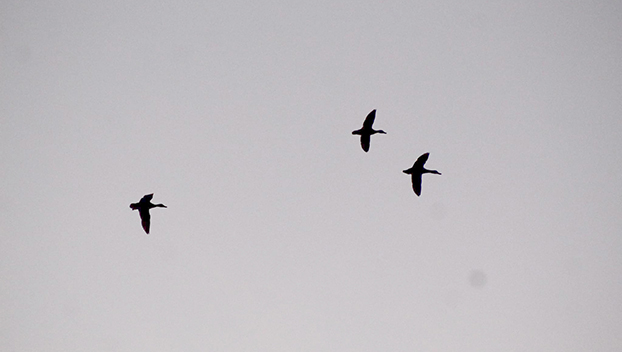November’s Aerial Waterfowl Survey reports low birds, dry habitat
Published 2:15 pm Monday, November 25, 2024

- Three ducks fly over St. Catherine Creek National Wildlife Refuge south of Natchez. (File Photo | Hunter Cloud)
By Houston Havens and Darrin Hardesty
Mississippi Department of Wildlife, Fisheries and Parks
The first MDWFP aerial waterfowl survey of the season occurred November 12 – 15, 2024, and similar to November 2023, dry conditions dominated observations across the Mississippi Delta. Shallow, seasonal water was not widely distributed during this survey, which is common for this time of year in Mississippi.
Trending
Public lands are currently providing a large proportion of intensively managed waterfowl habitat, and as a result, ducks were seen responding to these areas in relatively high numbers compared to the rest of the Delta.
Ducks were also observed using areas with large complexes of managed water across multiple private properties. As a result of the dry fall, most harvested agricultural fields have been disked, which will result in reduced food availability for waterfowl even if the fields are eventually flooded. Much opportunity remains for landowners and managers to capture rainfall with water control structures as fall and winter continue along, and as more waterfowl migrate south into the state.
As in most years, flooded habitat availability was greatest in the northeast portion of the Delta. Duck abundance estimates for the Mississippi Delta were well below the November long-term averages for mallards, other dabbling ducks, and diving ducks (Tables 1 and 2). Dabbling ducks other than mallards comprised 87% of all duck observations. Green-winged teal, gadwall, and northern shovelers were the most abundant dabbling duck species observed overall. Scaup were the most abundant diving duck species observed.
The northwestern portion of the Delta contained the greatest abundances of all duck categories recorded: mallards, other dabblers, diving ducks, and total ducks overall. Low waterfowl numbers during this survey were likely driven by a combination of dry conditions and very mild weather, as similar results have been recently observed in other states in the Southeast.
The good news is the weather pattern this week has finally shifted to more favorable conditions for continued southern migrations and field reports over the last few days have noted increasing waterfowl numbers. It’s also important to note that Mississippi’s November duck estimates are often not strong indicators of where peak numbers could reach later in the winter.
In the Mississippi Delta, mallards and other dabbling ducks were most commonly observed using flooded agricultural fields. It should be noted that very few agricultural fields were flooded during this survey, but available flooded fields were attractive to ducks. And as usual, the greatest abundances of diving ducks were observed on aquaculture complexes. In general, ducks were not evenly distributed across available wetland habitat. Instead, ducks were observed together in relatively large groups (which is typical of early-season behavior) in areas with managed complexes of diverse wetland habitat.
Trending
Biologists expect ducks to begin to distribute further as new wetland habitats become available throughout the winter. A large portion of the state received much needed rain early this week, but habitat conditions in many areas will remain below average levels during the early part of the hunting season.
No concentrations of light geese (snow, blue, and Ross’) or greater white-fronted geese (commonly called specklebellies) were observed during this survey, but recent reports suggest that numbers are now increasing.
The regular duck hunting season is set to open Thursday, November 28, and MDWFP biologists are optimistic that state WMAs with groundwater pumping capabilities will continue to attract and hold waterfowl for an enjoyable start to the season.
Despite low duck numbers overall, public and private lands with the ability to manage water can often have great early season hunting success. Weekly waterfowl reports will begin the week following the duck season opener, and will include updates from Mississippi hunting reports, as well as weather and habitat conditions.
For weekly waterfowl reports and more on the MDWFP Waterfowl Program, visit MDWFP’s website.





